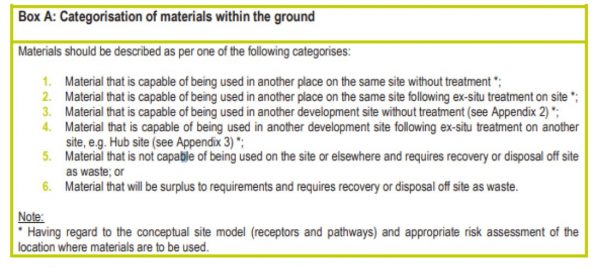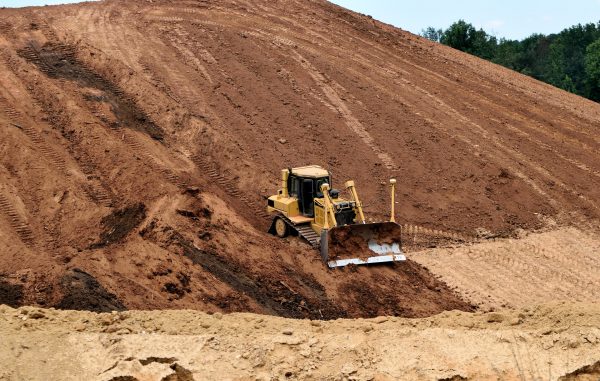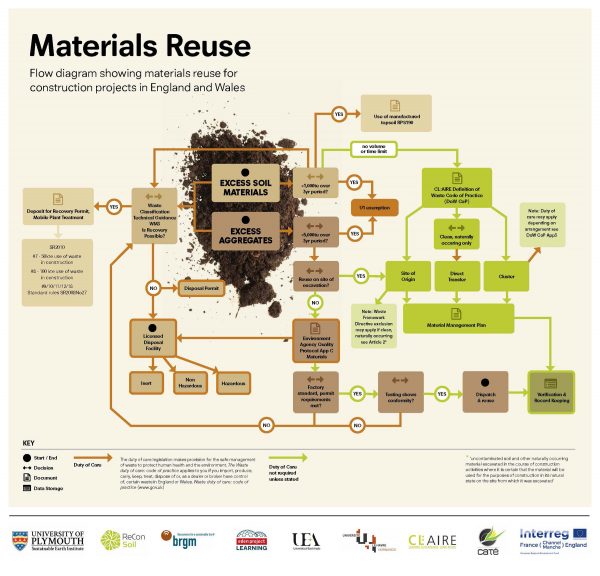The G&W Guide to… WASTE MANAGEMENT
Geoenvironmental • Industry matters • Regulation
Why did the waste consultant refuse custard on her treacle pudding? Because she believed in sauce separation.
 So, how do you deal with Waste or material that isn’t a Waste? And how do you re-use materials?
So, how do you deal with Waste or material that isn’t a Waste? And how do you re-use materials?
The first place to look has to be the CL:AIRE Definition of Waste Code of Practice (DoWCoP).

The CL:AIRE DoWCoP facilitates re-use by the mechanisms 1 to 4 in Box A above. Any materials falling under points 5 and 6 of Box A, will be classified as Waste.
NOTE: The CL:AIRE DoWCoP is voluntary and applies to England and Wales only.
It remains the case that demonstrating if a material is Waste or not, or when it ceases to be Waste, can be made without reference to DoWCoP on a case-by-case basis. It is likely, however, that an acceptable site-specific demonstration will draw upon very similar lines of evidence to those detailed in DoWCoP.
The Code of Practice (CoP) relates to excavated material, which includes:
- Soil, both top soil and sub-soil, parent material and underlying geology
- Soil and mineral-based dredgings
- Ground-based infrastructure that is capable of reuse within earthworks projects. E.g. road base and concrete floors
- Made ground
- Source segregated aggregate material arising from demolition activities, such as crushed brick and concrete, to be reused on the site of production within earthworks projects or as sub-base or drainage materials
- Stockpiled excavated materials that include the above.
The CoP applies to both uncontaminated and contaminated material from man-made and natural sources excavated:
- For use on the site from which it has been excavated, either without treatment or after on-site treatment (required treatment is an indication a material is a waste) as part of the development of that land (I.e. Site of Origin scenario)
- For use directly without treatment at another development site subject to the material meeting the requirements set out in Appendix 2 of the CoP (I.e. Direct Transfer scenario)
- For the use in the development of land other than the site from which the material has been excavated, following treatment at a Hub site which is covered by an Environmental Permit including a fixed Soil Treatment Facility (STF) acting in this capacity (I.e. Cluster Project scenario)
- Or a Combination thereof.
The Environment Agency (EA) will take into account the DoWCoP when deciding whether to regulate the materials as Waste (this comment basically means, that although voluntary, as the EA regulates Waste, if they want it done the DoWCoP way, then it needs to be done DoWCoP way).
If materials are dealt with in accordance with this DoWCoP the EA considers that those materials are unlikely to be Waste if they are used for the purpose of land development. This may be because the materials were never discarded in the first place, or because they have been submitted to a recovery operation and have been completely recovered, so that they have ceased to be Waste.
 Good practice has three basic steps:
Good practice has three basic steps:
- Ensuring that an adequate Materials Management Plan (MMP) is in place, covering the use of materials on a specific site.
- Ensuring that the MMP is based on an appropriate risk assessment, that underpins the Remediation Strategy or Design Statement, concluding that the objectives of preventing harm to human health and pollution of the environment will be met if materials are used in the proposed manner – the use of the material must not make the situation worse. Factors affecting the risk assessment are as follows:
Factor 1: Protection of human health and protection of the environment. Ensure that the aim of the Waste Framework Directive is not undermined. All measures to protect the environment and prevent harm to human health have to be assessed and found to be adequate given the proposed use of the materials. If the use of the material will create an unacceptable risk of pollution of the environment or harm to human health it is likely to be waste.
Factor 2: Suitability for use. The material must be suitable for its intended purpose in all respects; in particular, both its chemical and geotechnical properties. Certain excavated materials may be suitable for their intended use in the proposed development without any treatment at all. If they are used in that way those materials are unlikely to be Waste. If treatment is needed in order to make the material ready for use the material will be Waste but may cease to be Waste once treated so as to be suitable for use.
Factor 3: Certainty of Use. Demonstrate that the material will actually be used and that the use is not just a probability. For example, if materials are stockpiled with no pre-defined destination and use, they will still be Waste.
Factor 4: Quantity of Material. Materials should only be used in the quantities necessary for that use, and no more. The use of an excessive amount of material will indicate that it is being disposed of and is still Waste. In order to demonstrate these four factors a Materials Management Plan is produced which helps to ensure that the above matters are considered and a correct determination is made in relation to the nature of the materials.
- Ensuring that materials are actually treated and used as set out in the MMP and that this is subsequently demonstrated in a Verification Report.
NOTE: In order to comply with DoWCoP to confirm that steps 1 and 2 have been taken, a Qualified Person (Ground & Water has these) must review the relevant documents and provide a declaration to the EA prior to the use of materials.
You can download a PDF of the Material Re-use chart HERE
When the declaration is provided to the EA demonstrating that the materials are to be dealt with in accordance with the MMP, the EA – subject to the comments in the following paragraph – will take the view that the materials are not Waste.
If it turns out that materials were not used in accordance with the MMP and risk assessment, or if it is discovered that materials are not suitable for use, are used or planned to be used in excessive quantities, or are likely to cause harm to human health or pollution of the environment, the EA may conclude that those materials have been discarded and are Waste.
In order to prove that materials have been treated and used in an acceptable manner, a Verification Report must be prepared at the conclusion of works (as per step 3 above) and, if requested, provided to the EA. Completion of a Verification Report will not prevent consideration of the above matters by the EA. If excavated materials are used without following this CoP, the EA may take the view that the excavated materials are Waste and are thus subject to legislative control.
NOTE: There is another side to whether materials stockpiled for remediation are waste or not. If following treatment they become suitable for use, then re-use is acceptable.

It should be noted that DoWCoP relates to the issue of whether or not materials should be classified as Waste. If the requirements of this CoP are complied with the material will not be Waste.
If the material is Waste an Environmental Permit will be required to lawfully deposit or re-use it unless the material is “uncontaminated soil and other naturally occurring material excavated in the course of construction activities where it is certain that the material will be used for the purposes of construction in its natural state on the site from which it was excavated”, which is excluded from Waste Regulation by the Waste Framework Directive (2008).
A U1 Waste Exemption allows the following:
- Using crushed bricks, concrete, rocks and aggregate to create a noise bund around a new development and then using soil to landscape the area
- Using road planings and rubble to build a track, path or bridleway
- Using woodchip to construct a track, path or bridleway
- Bringing in soil from somewhere else to use in landscaping at housing developments.
NOTE: This is only related to re-use of materials on site of origin.
Under a U1 Waste Exemption you cannot:
- Treat Waste to make it suitable
- Dispose of Waste by using Waste that is unsuitable or by using more Waste that is needed. (You need to justify the amount needed)
- Use Waste for land reclamation
- Register this exemption more than once at the same place for three years after registration
- De-register then re-register the same exception within a three-year period
- Store the Waster for longer than 12 months before you use it.
NOTE: A total of 1,000 tonnes of 17 05 04 waste (soil and stones not containing hazardous substances) can be used under this exemption. However, you need to register the exemption.
In the DoWCoP, “land development” includes redevelopment, remediation and regrading. This document therefore applies not only to development carried out under the development control regime (and sites benefiting from permitted development rights), but also to remediation activities which may occur outside of that regime, e.g. remediation and reuse of materials as a direct result of a spillage or leak on an industrial site or at the surrender stage of a permit.
To re-iterate however, the DoWCoP is voluntary and applies to England and Wales only, and is the fundamental basis on which the EA will assess whether a material is Waste or not.
So how does Ground & Water help clients with Waste Management?
Ground & Water is capable of writing MMPs for clients for QP sign off and EA approval. If you are a local developer with a number of development sites being worked on at any one time, this may be a golden opportunity to save money and start using the ground as a commodity.
We also have Qualified Persons (QPs) who can review and declare MMP’s, as long as they (the QPs) have not been part of the MMP writing/assessment process.
The CLAIRE GUIDE can be downloaded HERE

 Good practice has three basic steps:
Good practice has three basic steps: